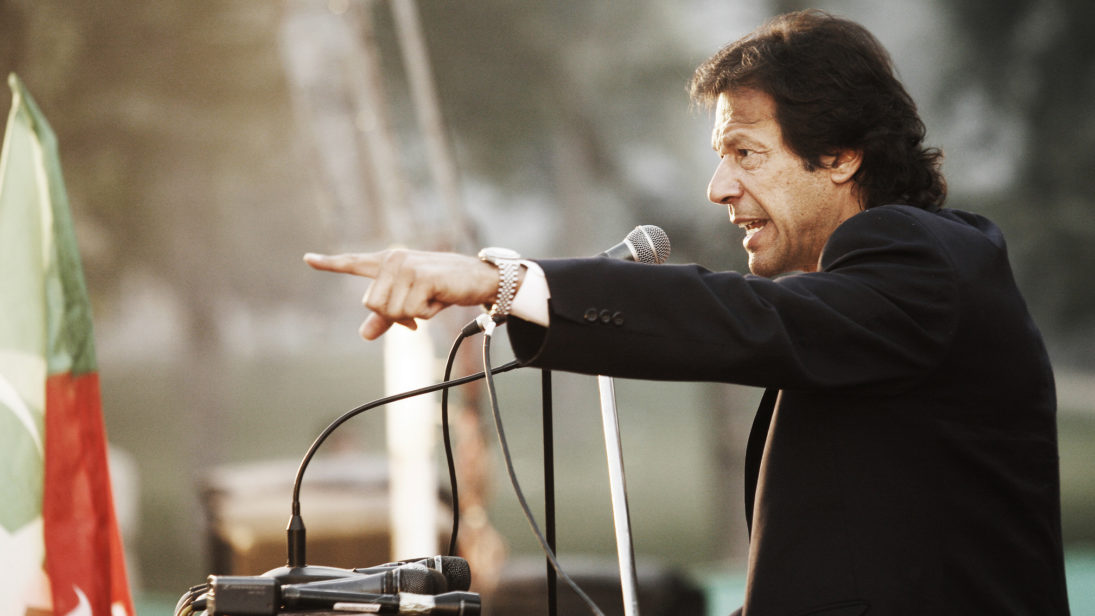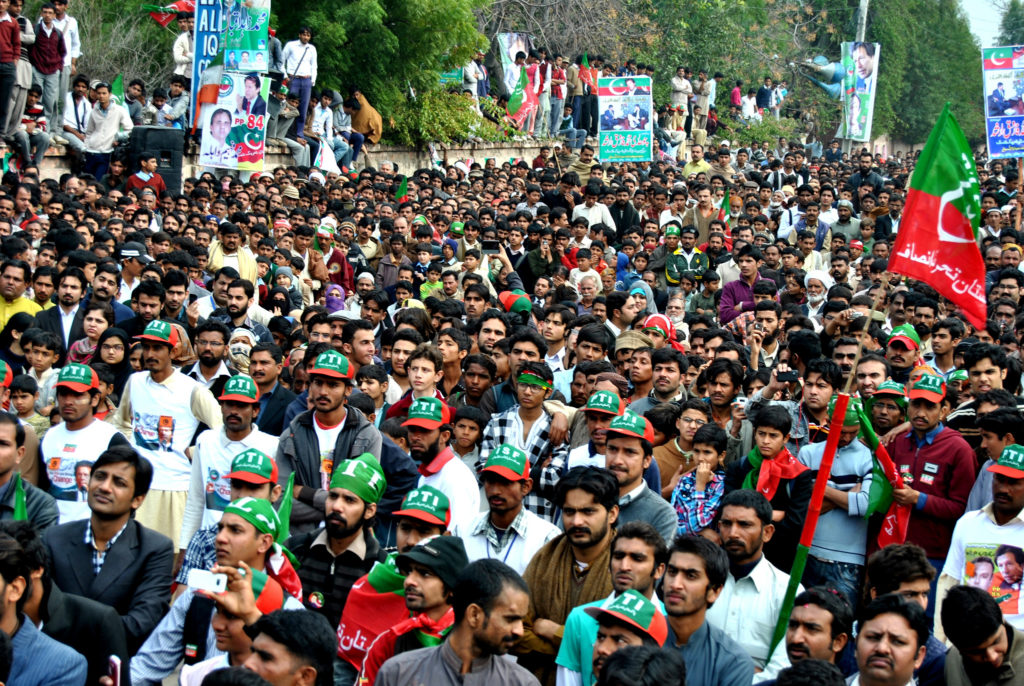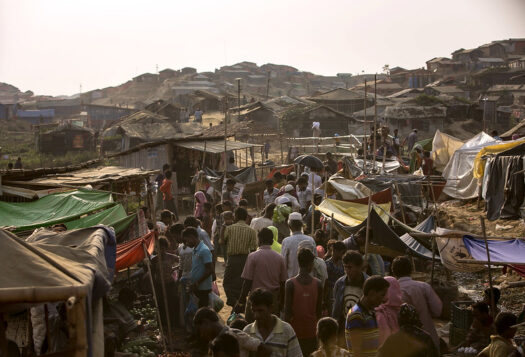
With the election of the country’s 22nd prime minster, Imran Khan, 2018 proved to be a consequential year for Pakistan. It was the first national win for Khan’s Pakistan Tehreek-e-Insaf (PTI) party, marking a shift in a country that has traditionally alternated power between the Pakistan People’s Party (PPP) and Pakistan Muslim League-Nawaz (PML-N). While Pakistan made headways in reducing terrorist violence in 2018, political instability in the run-up to the elections—marked by street mobilization of the religious right—had a deleterious impact on Pakistan’s economic growth. Old stresses and strains in Pakistan-U.S. relations have continued; however, the American pursuit of a political solution in Afghanistan has led to cautious engagement.
While Imran Khan’s opening salvo emphasizing domestic and external reconciliation, socio-economic resuscitation, and good governance pleased even critics, developments since then have raised questions about PTI’s ability to govern effectively.
PTI in Power: Performance So Far
Though still in its early days, the new government has demonstrated inexperience while struggling to institute sound economic policy. While Imran Khan’s opening salvo emphasizing domestic and external reconciliation, socio-economic resuscitation, and good governance pleased even critics, developments since then have raised questions about PTI’s ability to govern effectively. Announced cuts in development spending and hikes in gas tariffs and taxes on the wealthy drew a mixed response as inflation began to set in. Short on hard currency and in the midst of a balance of payments crisis, the ruling party gave mixed signals about whether it would approach the International Monetary Fund (IMF). Its ultimate decision to enter into negotiations has yet to bear fruit. The Finance Minister marked the government’s 100th day in office by declaring the balance of payments crisis over, before a striking devaluation of the rupee only a day later that came as a huge shock. There was also ambiguity with respect to China’s future role in Pakistan’s economic growth. While the government entered talks to broaden the base of the China-Pakistan Economic Corridor (CPEC), the Prime Minister’s economic adviser suggested a year-long hold on Chinese-funded projects to allow for a review process.
The government’s main strategy for economic revival has rested on an ambitious project of building five million homes for lower income families over the next five years, which is projected to create six million jobs while raising demand in 40 associated industries. With an estimated cost of USD 180 billion—more than half of Pakistan’s GDP—the government’s spokesperson on the economy provided little clarity on the funding source for the housing project. In times of austerity, it is expected to come mainly from the private sector.
Religious Extremism: Confronting the TLP
The street mobilization of a new religious party, the Tehreek-e-Labbaik Pakistan (TLP), in response to the PML-N government’s Election Reform Bill in November 2017, gained momentum as the TLP emerged as the fifth largest party in Pakistan by number of votes received. While Pakistan’s majoritarian electoral system ensured that the large number of votes translated to only two seats in Sindh’s provincial assembly, the TLP once again mobilized strongly in response to the acquittal of a Christian woman, Asia Bibi, on charges of alleged blasphemy in November 2018. The initial reluctance of the state to rein in the TLP even after direct threats to the Prime Minister, the Army Chief, and the Chief Justice raised doubts about the government’s resolve despite the initial unequivocal warning from Imran Khan himself.
Rather than use to force against the TLP protesters and risk a repeat of last year’s Faizabad clashes, the PTI government instead negotiated a five-point pact to end the country-wide sit-in. The pact acceded to the protesters’ major demand of adding Asia Bibi’s name to the Exit Control List (ECL) after due process while failing to reprimand the TLP leadership for its call for open rebellion against the state and government. Only later was a police operation launched that put Khadim Rizvi and the TLP leadership under protective custody. As Pakistan looks to strengthen its democracy, it will have to reckon with its Second Amendment, the blasphemy law, and with religio-political actors spewing venom for electoral gain. In a 27-year period from 1986 to 2003, the blasphemy law was used against Muslims in 42 percent of cases, a fact that speaks to the frequency with which the law has been misused to settle personal vendettas.

United States, Afghanistan, and India: Pakistan’s Foreign Policy
Since President Trump’s ascension, Pakistan-U.S. relations have deteriorated with Trump’s blatant accusations of Pakistani support to terrorists. In recent months though, the two states have been drawn together by the prospect of a peaceful resolution of a seemingly intractable conflict in Afghanistan. For Pakistan, relations with the United States will be determined by the extent to which support is offered for the United States to credibly exit from Afghanistan. This is Pakistan’s best bet in a relationship that has been mired for over a decade in accusations and counter-accusations over the Quetta Shura, the Haqqani network, the Salala incident, and the Abbottabad operation against Osama Bin Laden. American diplomatic overtures towards the Taliban provide a historic window of opportunity for Pakistan’s long-standing position that a political solution is the way forward.
For Pakistan, relations with the United States will be determined by the extent to which support is offered for the United States to credibly exit from Afghanistan…American diplomatic overtures towards the Taliban provide a historic window of opportunity for Pakistan’s long-standing position that a political solution is the way forward.
As peace in Afghanistan is pursued, a major point of friction between Pakistan and the United States is the latter’s claim of Pakistan’s influence over the Taliban. Although Pakistan, Saudi Arabia, and the United Arab Emirates have recognized the Taliban regime, Pakistan’s leverage over the Taliban remains limited due to the latter’s financial and operational independence. Pakistan should ensure that the peace process not only continues but reaches fulfillment.
Despite Pakistan’s failed attempt at dialogue with India and harsh speeches at the United Nations General Assembly this year, the opening of the Kartarpur border crossing has been a positive step in the right direction. Consolidating regional peace will be imperative for Pakistan’s economic rejuvenation. Pakistan’s current trade with India stands at $2.6 billion, while the full potential of open bilateral trade between the two countries is projected to be $30 billion.
Looking Ahead at 2019
Three key issue areas are pivotal for Pakistan in 2019. First, for the relatively new government, making good on socio-economic promises will be the utmost challenge going into next year. If by-election results and those of the last three general elections are anything to go by, the ruling party could suffer a dip in popularity if the dream of “Naya Pakistan” fails to materialize. Relatedly, it is imperative that Pakistan also seek foreign investment to spur economic growth in a dire situation where the GDP growth rate for 2019 is expected to slow down to 4.8 percent compared to 5.8 percent in 2018.
Second, a key challenge for 2019 is addressing negotiations with the Financial Action Task Force (FATF). In October, the FATF meeting urged Pakistan to intensify action on strategic counter-terrorism-related deficiencies. With the next meeting due in January and final status of negotiations to be determined in September next year, Pakistan’s priorities require ensuring satisfactory compliance with FATF regulations.
Finally, a negotiated political settlement in Afghanistan remains Pakistan’s best hope. President Trump’s mix of accusations of Pakistani duplicity and subsequent calls for assistance is indicative of American anxiety in ending the Afghanistan imbroglio. As the United States and Pakistan enter into potential talks with the Taliban, joining the peace initiative with the United States and ensuring its success could well be Pakistan’s greatest achievement in 2019.
Editor’s Note: As 2018 winds down, SAV contributors from India, Pakistan, Afghanistan, Bangladesh, Nepal, and Sri Lanka look back at the year gone by, reflecting on significant political and economic developments in the subcontinent and assessing what these events may foretell about 2019. Read the series here.
***
Click here to read this article in Urdu.
Image 1: Pakistan Tehreek-e-Insaf via Flickr (cropped)
Image 2: Pakistan Tehreek-e-Insaf via Flickr


